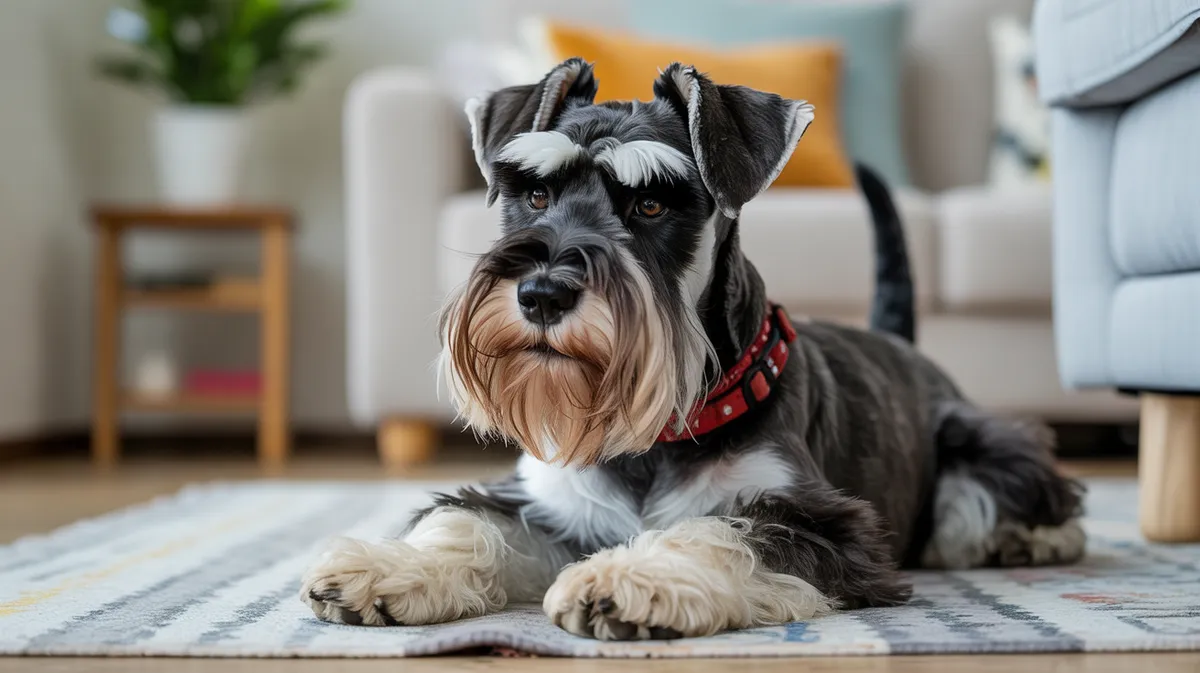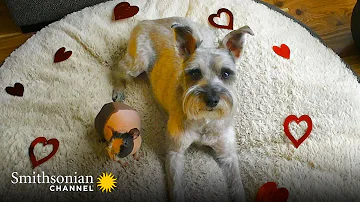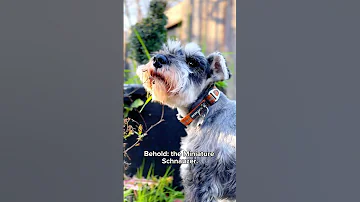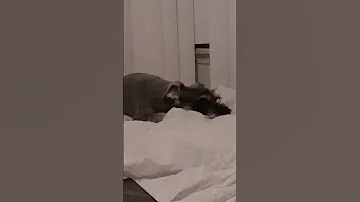
Miniature Schnauzer
Canis lupus familiaris

Meet the Miniature Schnauzer
The Miniature Schnauzer is a small, robust dog breed known for its distinctive bushy eyebrows, beard, and wiry double coat. Originating from Germany in the late 19th century, it was bred to be an efficient farm dog, excelling at ratting and guarding property. Miniature Schnauzers are highly intelligent, alert, and spirited, making them popular companion animals. They are adaptable, friendly, and enjoy being part of family life, thriving on human interaction and regular activity.
Classification
Mammal
Habitat
Domestic environments, urban and suburban homes
Diet
Omnivore
Lifespan
12-15 years
Conservation
Least Concern
Weight
5-9 kg (11-20 lbs)
📖Fascinating Facts
Distinctive Looks
Miniature Schnauzers are instantly recognizable by their prominent eyebrows and beard, which require regular grooming to maintain their signature appearance.
Rodent Catchers
Originally bred to hunt rats on German farms, Miniature Schnauzers have a strong prey drive and remain alert and energetic companions.
Talented Performers
This breed excels in obedience, agility, and even therapy work, thanks to their intelligence and eagerness to please.
📋Detailed Description
The Miniature Schnauzer is a compact, squarely built dog, typically weighing between 5–9 kg (11–20 lbs) and standing 30–36 cm (12–14 in) at the withers for males, with females slightly smaller. Its hallmark features include a robust, muscular frame, a pronounced rectangular head, bushy eyebrows, and a distinctive bristly beard and whiskers. The breed's double coat consists of a harsh, wiry outer layer and a soft undercoat, offering protection from harsh weather and rough terrain. Coat colors are internationally recognized as salt and pepper, black, black and silver, and, in some regions, white. Miniature Schnauzers are known for their keen intelligence, high trainability, and strong-willed yet affectionate temperament. They are alert and vocal, making them excellent watchdogs, but are generally not aggressive. Their energy levels are high, requiring regular mental and physical stimulation. Socially, they are loyal and thrive in close contact with their human families, often forming strong bonds with children and other pets. Anatomically, their strong jaws and agile bodies reflect their origins as ratters, and their acute senses of hearing and smell are well-developed. The breed typically lives 12–15 years, with some individuals reaching up to 17 years under optimal care.
💡 Did you know?
Despite their small size, Miniature Schnauzers have a bold and fearless personality, often acting as effective watchdogs.
🔬Research & Sources
Wikipedia Summary
The Miniature Schnauzer is a breed of small dog of the Schnauzer type that originated in Germany in the mid-to-late 19th century. Miniature Schnauzers may have been developed from the smallest specimens of the Standard Schnauzer, or crosses between the standard and one or more smaller breeds such as the Affenpinscher, Miniature Pinscher, and Poodles, as farmers bred a small dog that was an efficient ratting dog. They are described as "spunky" but aloof dogs, with good guarding tendencies without some guard dogs' predisposition to bite. Miniature Schnauzers are recognized in four colors internationally: solid black, black and silver, salt and pepper, and white.
Last Modified: 5/23/2025
🎭Behavior & Social Structure
Miniature Schnauzers are highly energetic, alert, and responsive dogs, exhibiting a strong prey drive inherited from their ratting ancestry. They are quick learners, excelling in obedience, agility, and scent work. Their daily routines often include bursts of playfulness interspersed with periods of vigilant observation. They are known for their tendency to vocalize, using barking as a means to alert their owners to perceived intruders or unusual activity. Socially, Miniature Schnauzers are people-oriented, preferring to be involved in family activities and displaying separation anxiety if left alone for extended periods. They are generally good with children and can coexist with other dogs, although early socialization is important to prevent territorial or dominant behaviors. Their feeding behavior is omnivorous, but they thrive on high-quality, protein-rich diets. While not typically aggressive, they may exhibit assertiveness toward unfamiliar animals or people, reflecting their guarding instincts.
👶Reproduction & Life Cycle
Miniature Schnauzers reach sexual maturity between 6 and 12 months of age, though responsible breeding is typically delayed until at least 18 months. The breed is monoestrous, with females coming into heat approximately twice a year. Mating is usually planned to ensure genetic health and minimize hereditary disorders. The gestation period averages 63 days, after which litters of 3 to 8 puppies are born. Neonatal care is intensive, with the dam providing warmth, nutrition, and grooming for the first three weeks. Breeders often assist with early socialization and health checks. Weaning begins at 3–4 weeks, and puppies are typically ready for adoption at 8–10 weeks. Miniature Schnauzers are attentive mothers, and responsible breeders screen for common genetic issues such as eye disorders and myotonia congenita.
🛡️Adaptations & Survival
The Miniature Schnauzer's wiry, weather-resistant coat is an adaptation to the harsh climates of rural Germany, allowing it to work outdoors in various conditions. Its compact, agile build and strong forequarters are ideal for pursuing and dispatching rodents in tight spaces. The breed's keen senses of hearing and smell are specialized for detecting small prey and alerting to intruders. Behaviorally, their intelligence and trainability are evolutionary advantages, enabling them to adapt to diverse roles, from farm work to urban companionship. Their vocal tendencies serve as an effective early warning system, while their sociable nature facilitates integration into human households.
📚Research Sources
🎨Cultural Significance
The Miniature Schnauzer has played a significant role in European and North American households since the early 20th century, valued for its versatility as both a working dog and a companion. In Germany, it was historically associated with small farms and rural households, serving as a symbol of industriousness and vigilance. The breed's distinctive appearance has made it a frequent subject in art, advertising, and popular media. Miniature Schnauzers are common participants in dog shows and agility competitions, and their image is often used to represent alertness and loyalty. There are no major mythological or ritual associations, but the breed's popularity has made it a cultural icon among small dog breeds.
🔬Recent Research & Discoveries
Recent genetic studies have clarified the Miniature Schnauzer's ancestry, confirming contributions from the Standard Schnauzer, Affenpinscher, and Poodle. Ongoing research focuses on breed-specific health issues, particularly genetic markers for eye diseases and metabolic disorders. Behavioral studies highlight the breed's high cognitive abilities and responsiveness to positive reinforcement training. Advances in veterinary care have improved management of common conditions such as pancreatitis and hyperlipidemia. The breed is also being studied for its suitability as a therapy and assistance dog due to its intelligence and sociability.
🎥Wildlife Videos

A Schnauzer & Bald Guinea Pig Strike Up a Friendship 🥰 Amazing Animal Friends | Smithsonian Channel
Dogs and guinea pigs are meant to be natural enemies–so how do you explain the friendship between Charlotte, a miniature ...
Smithsonian Channel

The truth about Miniature Schnauzers | pt. 1
A nature style documentary/mockumentary on Miniature Schnauzers. Mini Schnauzer owners will understand! Part 1.
Scotty the Schnauzer

dogs 101 - miniature schnauzer
I do not own anything, All rights to Animal Planet.
DogLover

Miniature Schnauzer Dog Breed Hidden Information Will Shock You
The Miniature Schnauzer is a German dog breed, that many people love. The Miniature Schnauzer is famous for his mustache, ...
Amazing Dogs

MINIATURE SCHNAUZER WALK GUDDEHJÄLM NATURE RESERVE 2025 (4K)
Miniature Schnauzers, with owners and friends, on a May Saturday morning walk in beautiful Guddehjälm Nature Reserve near ...
Bertil Lundin

Mini schnauzer sleeping on my bed.
Mr. Schnauzer Daily
🌍Habitat Information
The Miniature Schnauzer typically inhabits Domestic environments, urban and suburban homes environments. Miniature Schnauzers have adapted to their environments with specialized features and behaviors.
Primary Habitat:
Domestic environments, urban and suburban homes
More detailed habitat information will be available soon.
🛡️Conservation Status
The Miniature Schnauzer is currently classified as Least Concern. Conservation efforts are crucial for preserving this species for future generations.
Common Threats:
- 🏠Habitat loss and fragmentation
- 🌡️Climate change impacts
- 🎯Hunting and poaching
- 🏭Human-wildlife conflict
⚠️Threats & Conservation Challenges
As a domesticated breed, Miniature Schnauzers face few natural threats, but they are susceptible to several hereditary health conditions, including cataracts, progressive retinal atrophy, pancreatitis, and hyperlipidemia. Overbreeding and irresponsible breeding practices can exacerbate these issues. Obesity is a growing concern due to sedentary lifestyles in urban environments. While not threatened in terms of population, the breed's genetic diversity is a point of focus for breeders and kennel clubs. Human impact is generally positive, with strong demand for the breed as a companion animal, but puppy mills and unethical breeding remain challenges.
🔬Scientific Classification
Scientific Name
Canis lupus familiaris
Classification Hierarchy
🔍 About Taxonomic Classification
Taxonomic classification is a hierarchical system used by scientists to classify and organize living organisms based on shared characteristics and evolutionary relationships.
The system moves from broad categories (Kingdom) to increasingly specific ones, with each animal's scientific name typically consisting of its Genus and species.
📝Community Notes
Share your observations and insights about the Miniature Schnauzer with our community of wildlife enthusiasts.
Join Our Community
Sign in to share your observations and connect with fellow wildlife enthusiasts.
Sign In to ContributeNo community notes yet
Be the first to share your observations about the Miniature Schnauzer!
Explore Miniature Schnauzer
Select a tab above to learn more about this amazing animal.
📸Photo Gallery
No photos available for this animal yet.
🌟Discover More Wildlife
Continue your journey of discovery with more fascinating animals from our database
